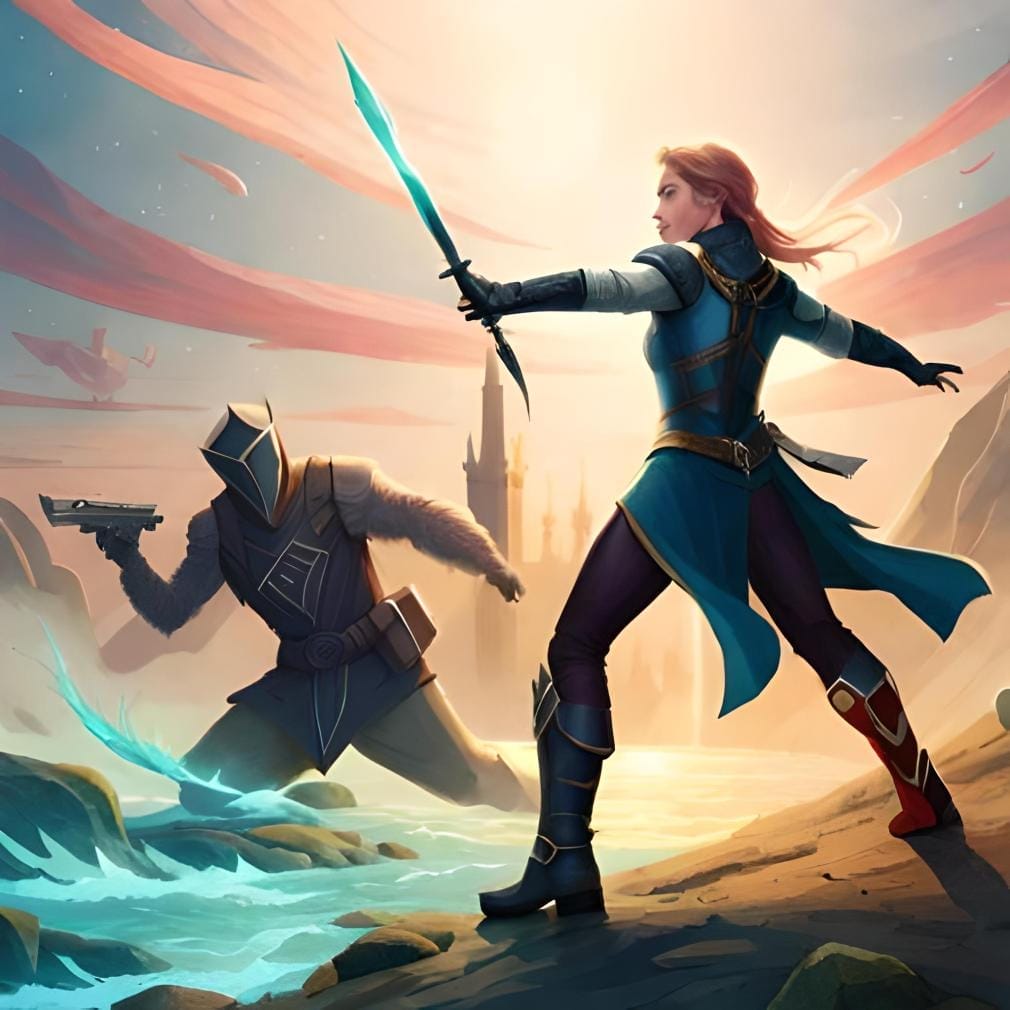Video games have become an increasingly popular form of entertainment, captivating audiences of all ages and backgrounds. As the industry continues to grow, it is essential for beginners to grasp the fundamental concepts of video game mechanics.
This article aims to provide a comprehensive overview of gameplay and game mechanics, shedding light on their role in shaping the player’s experience.
Gameplay refers to the interaction between players and the virtual world, while game mechanics establish the rules and methods for this interaction.
By exploring various types of games, such as role-playing games (RPGs), first-person shooter (FPS) games, and puzzle games, readers will gain a deeper understanding of the diverse mechanics at play.
Furthermore, key game mechanics like turns, action points, auction/bidding, and resource management will be examined, emphasizing their impact on gameplay.
Through the analysis of game design and the careful combination of mechanics, players can enhance their gaming experience.
This article serves as a valuable resource for aspiring game designers and individuals seeking to understand the intricacies of video game mechanics.
Game Mechanics For Beginners
Key Takeaways
- Gameplay is how players interact with a video game, while game mechanics provide rules and methods for player interaction.
- There are various types of games, such as RPGs, FPS games, platformers, puzzle games, simulation games, and party games.
- Game elements include campaign, checkpoints, co-op, cutscenes, difficulty settings, hit points, mana/magic, map/level, NPCs, sidequests, and experience points.
Game Mechanics and GamePlay

Gameplay basics encompass the fundamental elements of how players interact with a video game, including game mechanics, rules, and methods of player interaction.
Gameplay mechanics refer to the specific rules and systems that govern the actions and behaviors of players within a game. These mechanics can vary significantly depending on the genre of the game.
For instance, RPGs may include mechanics such as character customization, leveling up, and turn-based combat. FPS games, on the other hand, focus on mechanics like aiming and shooting. Platformers require players to navigate through levels by jumping and avoiding obstacles. Puzzle games emphasize problem-solving and critical thinking. Simulation games mimic real-life actions and often involve resource management.
Understanding the different game mechanics for each genre is crucial for aspiring game designers to create engaging and enjoyable gameplay experiences.
Types of Games

RPGs involve players assuming character roles in highly detailed virtual worlds. In these games, game mechanics play a crucial role in shaping the gameplay experience. Game mechanics in RPGs often include turn-based combat, character progression systems, and decision-making elements that affect the storyline.
Players have the ability to customize their characters, choose different skills or abilities, and engage in quests or side missions.
The role of game mechanics in puzzle games is different but equally important. In puzzle games, game mechanics revolve around solving puzzles or riddles. These mechanics may include manipulating objects, rearranging elements, or finding patterns. The challenge lies in figuring out the correct solution within the game’s rules and constraints.
Game mechanics in RPGs and puzzle games aim to engage and challenge players, giving them a feeling of accomplishment and satisfaction when they navigate through the game’s mechanics.
This is not a complete list, as games are constantly evolving and creating new genres. But here are some existing game genres:
Adventure Games , which often involve puzzle-solving within an engaging storyline. They transport players to various locations and engage them in narratives. Popular franchises like the classic ‘Monkey Island’ and contemporary titles like ‘Life is Strange’ are excellent examples of this genre.
Action Games demand fast reflexes and quick decision-making from players. These are typically high-adrenaline games that include combat and require players to overcome obstacles quickly. The ‘God of War’ series and ‘Devil May Cry’ are prime examples of action games.
Real-Time Strategy Games (RTS) which involve strategic decision-making where players must manage resources and armies to overcome opponents. These games occur in real-time, with all players acting simultaneously as opposed to taking turns. Examples include ‘StarCraft’ and ‘Age of Empires’.
Turn-Based Strategy Games (TBS) , unlike RTS games, allow players to take turns when playing. This genre emphasizes strategy and tactical thought, with games like ‘Civilization’ and ‘XCOM’ standing out as key examples.
Massively Multiplayer Online Role-Playing Games (MMORPG) are games that support large numbers of players simultaneously in the same game world. These games typically involve quests, raids, and exploration, with ‘World of Warcraft’ and ‘Final Fantasy XIV’ being well-known examples.
Survival Games place players in a hostile environment with the goal of survival for as long as possible. Players typically start with minimal resources and have to gather materials, build shelters, and find food. Examples include ‘Minecraft’ and ‘ARK: Survival Evolved’.
Battle Royale Games are a sub-genre of survival games. They involve numerous players that battle against each other until only one player, or team, remains. Popular games in this genre include ‘Fortnite’ and ‘PlayerUnknown’s Battlegrounds’.
Rhythm Games challenge players to follow the beat or rhythm of music tracks. These games often require precise timing and coordination. Titles like ‘Dance Dance Revolution’ and ‘Guitar Hero’ are popular examples.
Sports Games which simulate real-world sports, allowing players to control a team or individual athlete. They can cover a variety of sports, including football, basketball, racing, and more. Games like ‘FIFA’, ‘Madden NFL’, and ‘NBA 2K’ are among the most popular in this genre.
Stealth Games focus on avoiding detection by enemies rather than engaging them directly. This requires patience, accuracy, and strategic planning. Classic games like the ‘Metal Gear Solid’ series and ‘Splinter Cell’ are prime examples.
Role-Playing Games (RPGs) are a genre where players are invited to step into the shoes of a particular character in a meticulously-designed universe. They engage in a narrative-driven experience often filled with quests, exploration, and character development. Notable examples include the expansive worlds of The Elder Scrolls series, the post-apocalyptic landscapes of Fallout, and the fantastical medieval setting of The Witcher.
First-Person Shooters (FPS) provide a thrilling, action-packed experience directly from the viewpoint of the protagonist. There is no shortage of thrilling clashes in these games, ranging from the harsh battlegrounds of the Call of Duty series to the exotic realms teeming with extraterrestrial life in Halo. Players are tasked with battling through hordes of enemies to accomplish their mission.
Platformers , all about precision and timing as players guide their characters through a series of platforms and obstacles. The Super Mario series perfectly exemplifies this genre, immersing players in vibrant worlds where they guide Mario through a range of thrilling challenges. They must jump from platform to platform with skill and finesse, all while evading or conquering enemies that stand in their way.
Puzzle Games, which put a player’s problem-solving skills to the test. These games can range from traditional puzzle challenges like Sudoku and Tetris to more complex ones that integrate action elements, such as L.A. Noire, where players must solve a series of police cases in a dynamic open-world setting.
Simulation Games, as the name suggests, simulation games aim to provide a realistic representation of various activities or experiences. These games aim to provide players with a truly immersive experience, whether they’re navigating the virtual skies in Microsoft Flight Simulator, speeding around racetracks in Gran Turismo, or throwing punches in the boxing ring in Fight Night.
Party Games Designed with fun, communal play in mind, party games often pit players against each other in a series of mini-games or challenges. Games like Mario Party are perfect examples, offering a variety of engaging multiplayer activities designed to bring a dose of competitive fun to any gathering.
Key Game Mechanics

Key game mechanics are essential elements that shape the gameplay experience and provide structure and rules for player interaction.
One important game mechanic is resource management strategies, which involve the strategic management of finite resources within the game. Players must carefully allocate and utilize their resources to progress and succeed in the game. This mechanic adds depth and complexity to the gameplay, requiring players to make strategic decisions and prioritize their actions.
Another significant game mechanic is role-playing in virtual worlds. This mechanic allows players to assume the role of a character within the game and interact with the virtual environment and other players. Role-playing games (RPGs) often have rich narratives and immersive worlds that players can explore and engage with. Players can make choices that impact the story and develop their character’s abilities and skills. Role-playing mechanics provide players with a sense of agency and personalization, allowing them to create unique experiences within the game.
Game Mechanics vs. Gameplay
Game mechanics and gameplay are two of the most important concepts in game design. However, they are often confused with each other.
Game mechanics are the rules and systems that govern how a game works. They define what the player can do, how they can do it, and what the consequences of their actions will be. Game mechanics can be anything from the simple act of jumping in a platformer to the complex economic systems of a strategy game.
Gameplay is the player’s experience of interacting with the game mechanics. It is the moment-to-moment action of playing the game. Gameplay is what makes a game fun and engaging. It is what keeps players coming back for more.
The two concepts are closely related. Game mechanics provide the framework for gameplay, while gameplay is the manifestation of those mechanics in the player’s experience. A good game will have well-designed game mechanics that support engaging and enjoyable gameplay.
Here are some examples of game mechanics:
- Movement: The ability for the player to move around the game world.
- Action: The ability for the player to perform actions, such as attacking enemies or solving puzzles.
- Progression: The ability for the player to progress through the game, unlocking new content as they go.
- Rewards: The ability for the player to earn rewards for their actions, such as experience points or new items.
Here are some examples of gameplay:
- Solving a puzzle: The player must use the game mechanics to solve a puzzle, such as finding a way to cross a chasm or defeating a boss.
- Exploring a world: The player must explore the game world, finding new areas and completing challenges.
- Completing a mission: The player must complete a series of objectives, such as defeating enemies or collecting items.
- Competing against other players: The player must compete against other players, either individually or as part of a team.
Core, Primary and Secondary Mechanics in game design
The art of game design is crucial to creating captivating and immersive video games. It encompasses a range of mechanics that determine how players engage with the game’s world. These mechanics can broadly be categorized as Core, Primary, and Secondary mechanics.
Core Mechanics are the essence of the game – the fundamental actions a player can perform. They shape the basic gameplay experience, like running and jumping in platformers.
Primary Mechanics are built on top of these core mechanics. They are the most frequent and vital actions performed by a player, defining the game’s main genre. For instance, aiming and shooting in a first-person shooter game.
Lastly, Secondary Mechanics, while less frequent, add depth and complexity to the gameplay. They offer additional options or strategies, like crafting or trading in role-playing games, providing a rich and diverse gaming experience.
Together, these mechanics form the backbone of the game design, creating a cohesive and engaging gameplay experience.
Examples of core, primary and secondary mechanics
The classification of these mechanics into Core, Primary, and Secondary categories. Please note that the classification can vary based on the game design and genre:
Core Mechanics
- Exploration: Core to open-world games like The Legend of Zelda: Breath of the Wild or Skyrim.
- Crafting: Central in games like Minecraft or The Last of Us, where survival and progression heavily depend on creating items.
- Platforming: Fundamental in platform games like Super Mario Bros. or Celeste.
- Procedural Generation: Core to games like No Man’s Sky or Minecraft, where unique, vast game worlds are a significant aspect of the gameplay.
Primary Mechanics
- Puzzle Solving: Primary in games like Portal or The Witness where the main gameplay revolves around solving puzzles.
- Stealth: Crucial in games like Metal Gear Solid or Assassin’s Creed series, where stealth is a primary method of progression.
- Inventory Management: Primary in games like Resident Evil or The Witcher, where managing resources and items effectively is a significant part of gameplay.
- Dialogue Choices: Essential in narrative-focused games like Mass Effect or Telltale’s The Walking Dead series where player decisions can have significant story impacts.
Secondary Mechanics
- Time Management: Acts as a secondary mechanic in games like The Sims or Stardew Valley, adding a layer of challenge and strategy.
- Worker placement plays a crucial but often overlooked role in strategy games such as Civilization. While exploration and combat may take center stage, the skillful management of workers can greatly influence the final outcome.
Impact on Gameplay

The impact of game mechanics on the overall gaming experience is significant and can greatly affect player engagement and enjoyment.
Different game mechanics have their pros and cons, and understanding how they can enhance player engagement is crucial for game designers.
Iron sights in first-person shooters, such as mechanics, offer players enhanced control and immersion. Through this feature, players can experience a stronger connection to the game world, leading to an improved overall gaming experience.
Unskippable cutscenes and forced stealth in non-stealth games are incredibly bothersome and can significantly detract from the overall enjoyment of gameplay. These elements have the potential to cause frustration, disengagement, and ultimately diminish the enjoyment that players derive from the game.
By carefully considering and balancing game mechanics, designers can create an engaging and enjoyable gaming experience that keeps players coming back for more.
Game Design and Analysis

Analyzing game design and conducting thorough analysis of game mechanics is essential for creating a well-balanced and engaging gaming experience. Game mechanics play a crucial role in player engagement as they determine the rules and methods of player interaction within a video game. By understanding and analyzing game mechanics, game designers can ensure that the mechanics work together harmoniously to provide an enjoyable and immersive gameplay experience.
Here are five examples of game mechanics in popular video games:
- Skill trees in role-playing games (RPGs) allow players to customize their characters’ abilities and progress through the game according to their preferred play style.
- Cover mechanics in third-person shooters provide players with strategic options for taking cover and avoiding enemy fire.
- Crafting systems in survival games allow players to gather resources and create tools, weapons, and other items to aid their survival.
- Stealth mechanics in stealth-action games offer players the option to silently navigate through levels and take down enemies without being detected.
- Physics-based puzzles in puzzle-platformer games challenge players to solve environmental puzzles by manipulating objects and leveraging the game’s physics engine.
By carefully considering and implementing these game mechanics, game designers can create engaging and immersive gameplay experiences that keep players coming back for more.
Game Mechanic Example
One of the most effective ways to understand game mechanics is by examining a classic game. Let’s take Pac-Man, one of the most iconic and influential arcade games of all time, as our example.
Pac-Man is an exceptional choice, as it remains one of the most successful games ever developed, with a legacy that spans various platforms and generations. Moreover, it is highly probable that you are already acquainted with this captivating game.
Pac-Man can be broken down into four-game mechanics:
- Maze Navigation: The layout of the game board, how Pac-Man moves through the maze, and the strategies for avoiding or confronting ghosts.
- AI Behavior: The behaviors and movement patterns of the ghosts, which vary depending on the game state and time.
- Scoring Systems: The points you earn for eating pellets, fruits, and ghosts, with higher points for eating multiple ghosts in succession.
- Power-Ups: The player’s ability to use power-ups, such as the Power Pellet, which temporarily allows Pac-Man to eat the ghosts.
Although there are various additional elements incorporated in recent editions of Pac-Man, such as innovative game modes with distinct objectives and components, the four mechanics aforementioned represent the fundamental principles that truly encapsulate the essence of the Pac-Man encounter.
Exploring Game Mechanics for Effective Game Design
The role of game mechanics is crucial in game design as it not only drives the development of captivating features, but also ensures that these elements come together seamlessly to create a truly captivating and immersive gaming experience.
Every game designer strives to overcome the challenge of having a vast array of brilliant ideas that, regrettably, fail to be effectively translated into the context of their video game.
Upon receiving extensive feedback indicating that their game is overly repetitive, veteran designers typically revisit their design. They explore the possibility of incorporating new game mechanics to infuse a fresh layer of intrigue into the game.
If players find your game unexciting or quickly losing its initial charm, it could be a sign that you need to enhance the current game mechanics. Consider improving the rewards and outcomes provided, or adding greater complexity to the mechanics to bring a new layer of depth to the gameplay experience.
For individuals seeking to venture into game design, a beneficial exercise involves dissecting any game down to its core game mechanics. Commencing with simple traditional or mobile games before advancing to more intricate ones often proves productive in honing your understanding of game mechanics.
The more adept you become at scrutinizing and comprehending game mechanics, the more proficient you will be at conceptualizing your unique and noteworthy ideas. Practicing these techniques not only enhances your design thinking abilities, but also enables you to anticipate player responses and formulate effective strategies, thus resulting in the development of captivating and victorious games.
Frequently Asked Questions
What are some common strategies for resource management in video games?
Different approaches to resource management in video games include prioritizing essential resources, implementing efficient production systems, and utilizing resource-sharing mechanics. Effective strategies for optimizing resource usage involve careful planning, strategic decision-making, and resource conservation techniques.
How do game designers ensure that the game mechanics work together harmoniously?
Game designers ensure that game mechanics work together harmoniously by playtesting and iterating on their designs. They analyze how the mechanics impact player engagement and make adjustments to achieve a balanced and enjoyable gameplay experience.
What are some examples of games that have successfully combined multiple game mechanics?
Examples of games that have successfully combined multiple game mechanics include Middle Earth: Shadow of Mordor, which incorporates action-adventure mechanics with RPG elements, and Pokémon Shuffle, which combines puzzle mechanics with RPG progression. These games showcase how the thoughtful integration of mechanics can enhance player engagement.
How do game mechanics affect the overall balance and complexity of a game?
Game mechanics play a crucial role in determining the overall balance and complexity of a game. They impact player engagement and retention by providing challenges, rewards, and meaningful choices. Player feedback helps refine game mechanics to enhance the gameplay experience.
What are some examples of game mechanics that enhance gameplay and make it more enjoyable?
Examples of game mechanics that encourage player creativity include character customization, crafting systems, and open-world exploration. These mechanics give players the freedom to express themselves and create unique experiences. Game mechanics also play a crucial role in player immersion by providing realistic physics, dynamic environments, and immersive storytelling.
Conclusion Video Game Mechanics
In conclusion, video game mechanics are the heart and soul of the gaming experience. They are the rules, systems, and interactive elements that allow players to immerse themselves in the gaming world and have fun.
Traditional mechanics such as rewards, challenges, and exploration continue to be effective in captivating players. However, the rise of innovative mechanics such as procedural generation and physics-based interaction demonstrates the industry’s continuous evolution.
Online gaming and multiplayer platforms have changed the way we interact socially, turning video games into a means of building communities and connecting with others. The use of realistic and complex mechanics in educational and simulation games highlights the potential of video games for learning and skill development.
As the gaming industry continues to grow and evolve, it is crucial for developers to understand and implement effective game mechanics. By doing so, they can create engaging, immersive, and enjoyable experiences for players. As users, understanding these mechanics can enhance our appreciation and enjoyment of these digital masterpieces.
Video game mechanics are more than just tools for engagement. They are the foundation upon which all great games are built. They are the reason why we play games, and they are the reason why we keep coming back for more.
What do you think about this? Why don´t you share your opinion in the comments below? Also, don’t forget to comeback regularly to our blog for more interesting stories on game design and game designers.






















